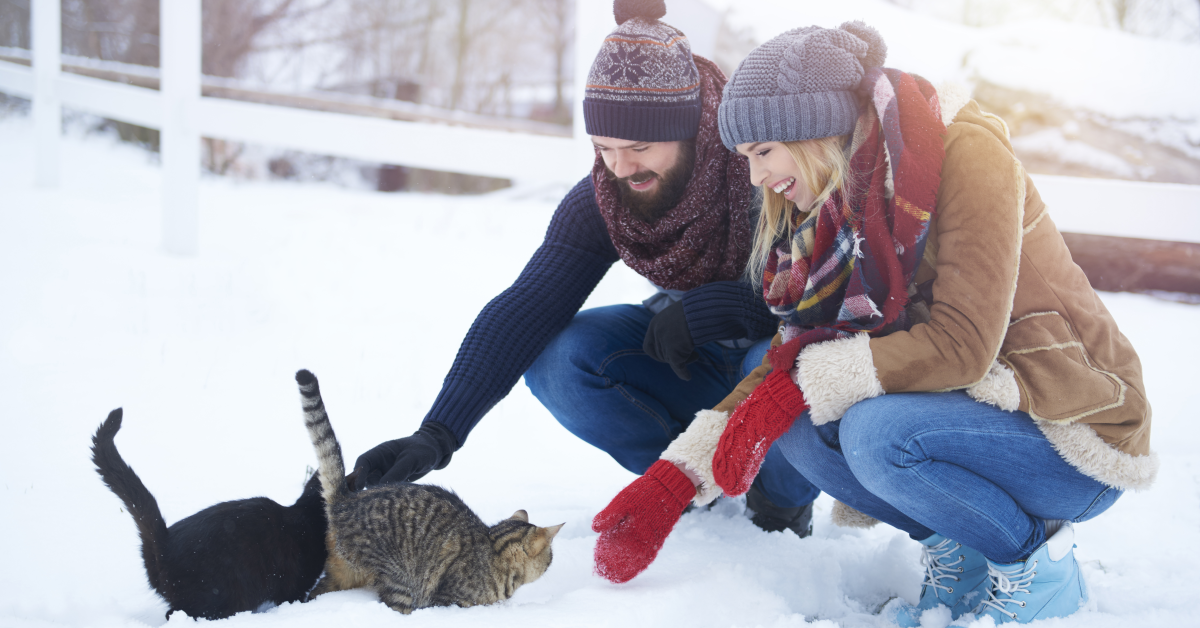Winter is Near: How Cold is Too Cold For Your Feline Friend?
How to keep your cat safe and healthy in the winter cold.

How cold is too cold for your beloved cat? Whether your cat spends a lot of time outdoors or is mostly a “lying by the fireplace” type feline, there are definite precautions you need to take to keep her warm and safe when winter winds howl.
Cats are Self-sufficient, Right?
Cats are indeed generally hardy and robust species, but that doesn’t mean they don’t need our care in winter. A cat’s average body temperature is 100.5 and 102.5, and anything less than that can mean serious trouble.
Even though an outdoor cat is tough and used to outside temperature fluctuations, when the temperatures fall to 45-degrees and below, it has become too cold for most cats. Anything below 32-degrees and the onset of hypothermia or frostbite becomes a genuine concern. However, not all cats are created equal, and other factors affect how cold is too cold for a particular cat. These factors include:
Body Mass
A thin cat doesn’t have any natural insulation, whereas a cat with some meat on her bones will fare better at the same temperature. However, a too-fat cat is not a healthy cat, so it’s all a matter of balance.
Coat Thickness
A cat whose breed comes from a cold climate will naturally withstand cold better than a cat whose breed originates from warmer climates. Breeds such as Main Coon and Russian Blues will generally withstand winter weather fairly well. In addition, cats with heavy, double-layered coats have their fur coats to keep them warm.
Coat Color
Especially on sunny days, the darker the coat, the warmer the cat. Dark-colored fur absorbs and keeps heat in, enabling these cats to stay warmer than their fair-haired cousins.
Health Issues
Sick, old, and young cats simply do not handle cold weather well. The reason for this is they cannot regulate their body temperatures like healthy cats. In addition, most older cats have arthritis, the pain of which is aggravated in cold weather.
Habitat Issues
It’s no surprise that outdoor cats handle cold weather much better than their home-based counterparts. Plus, they know how to find cozy-ish places to nestle in during especially cold spells. On the other hand, if an indoor cat somehow finds her way outside in the extreme cold, she doesn’t have the experience of knowing how to survive, which may cause her to panic.
The Danger Zones
Hypothermia and frostbite are the two dangers a cat can face when she is outdoors in extreme cold and for prolonged periods.
Hypothermia
The body temperature of a cat with hypothermia may drop below 100-degrees, the point at which the heart may stop pumping blood. The signs of a cat with hypothermia are:
- Cold skin
- Lethargy
- Sluggishness
- Dilated pupils
- Shivering
- Low heart rate
- Difficulty breathing
- Low blood pressure
- And in the worst case, coma
If your cat appears to be suffering from hypothermia, she needs immediate vet care. In the meantime, bundle her up in warm blankets or towels. Be careful not to use coverings that are too warm or hot.
Frostbite
Frostbite occurs when the temperature drops below 32-degrees, at which point a cat’s blood vessels near the skin contract. This then causes damage to the skin and tissues. The places a cat is most likely to get frostbite are her paws, ears, and tail. If your cat is an outdoor cat, it is easy to overlook the signs of frostbite, so be sure to pay extra attention to her in the winter.
The signs of frostbite may include:
- Gray or blue skin color in the area that’s affected
- Black skin if frostbite has progressed significantly
- Swelling in the area
- Skin that is markedly cold
- Blisters or sores in the area
Frostbite is a medical emergency, so call your vet right away. Your cat will need immediate treatment.
Avoiding Danger
It is easy to keep your cat toasty, warm, and safe during the cold season with some simple thought and planning. Here are some things you can do.
For Your Outdoor Cat
Outdoor Cat House
Like many people have outdoor dog houses to shelter dogs during nasty weather, some folks opt for outdoor cat houses. There are many outdoor cat houses on the market today, and the key things you want for your cat include:
- Plenty of insulation
- Protection from snow and rain
- Doors that only allow entry and exit for your cat – this prevents unwelcome critters from enjoying protection
It is still crucial to remember that your cat needs the protection only you can offer in your home in the coldest and harshest weather.
Outdoor Cat House with Heat
On-trend now and offering more protection is an outdoor cat house with heat. Many of these models are so cozy you’ll wish you could fit right in with your cat. Some things to look for include:
- Heated floor mat with a chew-resistant extension cord
- Sufficient waterproofing to keep your cat dry in all weather
- Flap on exit and entry points to keep the interior dry when the cat comes and goes
- Large/small enough for your cat
- Portability if you plan to move it around your yard
For Your Indoor Cat
House Temperature
A thermostat setting between 69 and 72-degrees is ideal for both humans and felines. However, when you’re out of the house during the day, it’s normal to reduce the temperature, but don’t adjust the thermostat any lower than 60-degrees. If you have kittens, old or sick cats, the 60-degree threshold may be too low, so consider a higher temperature to keep them cozy.
Sleeping
Nothing is as welcoming as a heated bed, and the same is true for your cat. Not that it would be heat-heated, but look for fleece throws or other soft materials for her to nestle, or maybe you have an old blanket you could give your cat to curl up in. You could also purchase a cat bed. Many different shapes and sizes of beds are available to purchase in a local pet store or order online.
Cats typically like to find their own coveted sleeping spots, and in the winter, they are quite adept at finding the warmest places in the house. When you discover those places, make a little bed out of the materials you have found for her bed, or place the bed you purchased, lined with fleece or other material.
Diet Considerations
Do you know how we humans crave warm soups, heavy stews, and other hearty foods during the winter months? We need the extra fuel because we burn more calories to keep warm. The same is true for your cat. Cats need more food in winter, consider an extra meal, and make sure there is always plenty of water available.
Despite their natural resilience, cats still need lots of TLC during the harsh days of winter. By following these simple tips, your cat will be safe and healthy, and you’ll both enjoy cozy times together.
Ready to start saving money on pet wellness care?
Then take a look at Mint Wellness, the pet wellness plan that provides fast reimbursement on routine pet care. Save on vaccinations, wellness exams, preventatives, dental, and more!
Learn More


